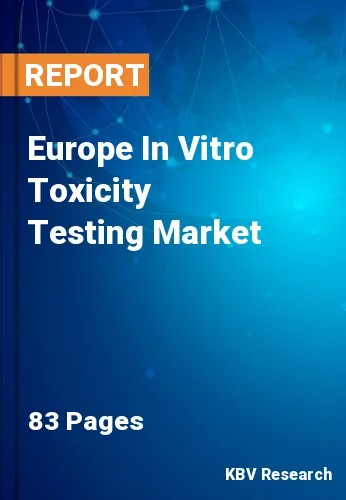The Europe In Vitro Toxicity Testing Market would witness market growth of 10.4% CAGR during the forecast period (2022-2028).
In vitro methods are now widely employed in safety evaluation, risk appraisal, and toxicity testing by all regulatory authorities and sectors. The advantages of in vitro procedures over testing on animals are the primary factor behind their usage. The in vitro approach is mostly utilized to find out how a drug's toxicity works and how it affects a cell or tissue. The introduction of the Ames Mutagenic Assay increased the popularity of non-animal testing over animal testing.
Regulatory hurdles and political obstacles are also anticipated to enhance the sector. Many countries are more likely to push this industry because of ethical concerns about animals. Animal testing restrictions are severe in countries like Europe, thus enterprises operating in this area are likely to flout them and opt for in vitro toxicology testing instead for a variety of product development and research purposes. Other growing Asian nations are expected to follow suit, resulting in improved and faster development of in vitro testing methods. Enhanced economic circumstances will also aid in the acceptance of new technology, resulting in immediate potential enhancements in the cosmetics, chemical, food industries, and pharmaceutical.
The processes and laws for the marketing authorization of pharmaceutical products for human use in the European Union are principally outlined in Regulation 2001/83/EC of the European Parliament and Council. The European Medicines Agency's Protocol on Non-Clinical Local Tolerance Assessing of Medicinal Products should be followed while testing skin sensitization.
Due to increased healthcare awareness connected to blood reaction and donating, greater per-capita income and expenditure, and enhanced patient infrastructure, Europe is a significantly large in vitro toxicity testing market.
The sensitizing potential of drug products applied to the skin or plan to participate should be assessed in risk assessments before being administered to people, according to this recommendation (EMA, 2015). This encourages the use of in vitro toxicity testing.
The Germany market dominated the Europe In Vitro Toxicity Testing Market by Country in 2021, and would continue to be a dominant market till 2028; thereby, achieving a market value of $2.4 billion by 2028. The UK market is estimated to grow at a CAGR of 9.5% during (2022 - 2028). Additionally, The France market would showcase a CAGR of 11.2% during (2022 - 2028).
Based on Type, the market is segmented into Absorption, Toxic Substances, and Dose. Based on Technology, the market is segmented into Cell Culture Technologies, High Throughput Technologies, and Toxicogenomics. Based on End User, the market is segmented into Cosmetics & Households Products, Pharmaceuticals Industry, Food Industry, Chemicals, and Industry. Based on countries, the market is segmented into Germany, UK, France, Russia, Spain, Italy, and Rest of Europe.
Free Valuable Insights: The Global In Vitro Toxicity Testing Market Size will Hit $37.5 Billion by 2028, at a CAGR of 10.8%
The market research report covers the analysis of key stake holders of the market. Key companies profiled in the report include Thermo Fisher Scientific, Inc., General Electric (GE) Co., AstraZeneca PLC, Catalent, Inc., Laboratory Corporation of America Holdings, Acacia Pharma Group Plc, GlaxoSmithKline PLC, Helsinn Healthcare SA., and Heron Therapeutics, Inc.
By Type
By Technology
By End User
By Country
Our team of dedicated experts can provide you with attractive expansion opportunities for your business.

